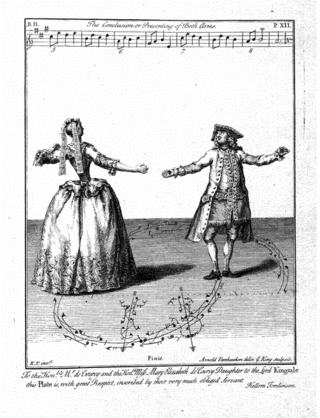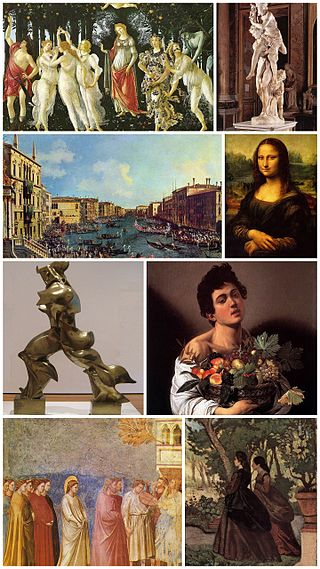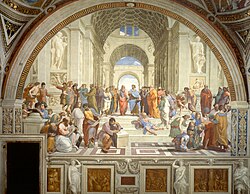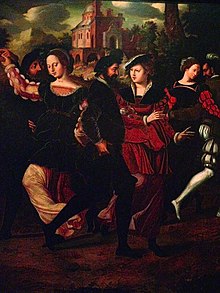
Baroque dance is dance of the Baroque era, closely linked with Baroque music, theatre, and opera.

A country dance is any of a very large number of social dances of a type that originated in England in the British Isles; it is the repeated execution of a predefined sequence of figures, carefully designed to fit a fixed length of music, performed by a group of people, usually in couples, in one or more sets. The figures involve interaction with your partner and/or with other dancers, usually with a progression so that you dance with everyone in your set. It is common in modern times to have a "caller" who teaches the dance and then calls the figures as you dance. Country dances are done in many different styles.

Renaissance art is the painting, sculpture, and decorative arts of the period of European history known as the Renaissance, which emerged as a distinct style in Italy in about AD 1400, in parallel with developments which occurred in philosophy, literature, music, science, and technology. Renaissance art took as its foundation the art of Classical antiquity, perceived as the noblest of ancient traditions, but transformed that tradition by absorbing recent developments in the art of Northern Europe and by applying contemporary scientific knowledge. Along with Renaissance humanist philosophy, it spread throughout Europe, affecting both artists and their patrons with the development of new techniques and new artistic sensibilities. For art historians, Renaissance art marks the transition of Europe from the medieval period to the Early Modern age.

The Italian Renaissance was a period in Italian history between the 14th and 16th centuries. The period is known for the initial development of the broader Renaissance culture that spread across Western Europe and marked the transition from the Middle Ages to modernity. Proponents of a "long Renaissance" argue that it started around the year 1300 and lasted until about 1600. In some fields, a Proto-Renaissance, beginning around 1250, is typically accepted. The French word renaissance means "rebirth", and defines the period as one of cultural revival and renewed interest in classical antiquity after the centuries during what Renaissance humanists labelled as the "Dark Ages". The Italian Renaissance historian Giorgio Vasari used the term rinascita ("rebirth") in his Lives of the Most Excellent Painters, Sculptors, and Architects in 1550, but the concept became widespread only in the 19th century, after the work of scholars such as Jules Michelet and Jacob Burckhardt.

Historical dance is a term covering a wide variety of Western European-based dance types from the past as they are danced in the present. Today historical dances are danced as performance, for pleasure at themed balls or dance clubs, as historical reenactment, or for musicological or historical research.
Domenico da Piacenza, also known as Domenico da Ferrara, was an Italian Renaissance dancing master. He became a very popular teacher with his students – most notably Antonio Cornazzano and Guglielmo Ebreo da Pesaro – who both later became successful dance masters. At a time between 1452 and 1463, he received the Order of the Golden Spur.
Alfonso Ferrabosco was an Italian composer. While mostly famous as the solitary Italian madrigalist working in England, and the one mainly responsible for the growth of the madrigal there, he also composed much sacred music. He also may have been a spy for Elizabeth I while he was in Italy.

The cultural and artistic events of Italy during the period 1400 to 1499 are collectively referred to as the Quattrocento from the Italian word for the number 400, in turn from millequattrocento, which is Italian for the year 1400. The Quattrocento encompasses the artistic styles of the late Middle Ages, the early Renaissance, and the start of the High Renaissance, generally asserted to begin between 1495 and 1500.

The basse danse, or "low dance", was a popular court dance in the 15th and early 16th centuries, especially at the Burgundian court. The word basse describes the nature of the dance, in which partners move quietly and gracefully in a slow gliding or walking motion without leaving the floor, while in livelier dances both feet left the floor in jumps or leaps. The basse danse was a precursor of the pavane as a dignified processional dance. The term may apply to the dance or the music alone.
Shakespearean dance refers to dancing in the time and plays of William Shakespeare and his contemporaries.
The ballo was an Italian dance form during the fifteenth century, most noted for its frequent changes of tempo and meter. The name ballo has its origin in Latin ballō, ballāre, meaning "to dance", which in turn comes from the Greek "βαλλίζω" (ballizō), "to dance, to jump about". In Greece there is the Greek dance named Ballos.

The modern state of Italy did not come into being until 1861, though the roots of music on the Italian Peninsula can be traced back to the music of ancient Rome. However, the underpinnings of much modern Italian music come from the Middle Ages.

Guglielmo Ebreo da Pesaro was a Jewish Italian dancer and dancing master at some of the most influential courts in Renaissance Italy, including Naples, Urbino, Milan, and Ferrara. His byname Ebreo means simply ‘Hebrew.’ Not always used when referring to him, da Pesaro indicates that he was from the east-central town of Pesaro. Between October 1463 and May 1465, Guglielmo probably converted from Judaism to Roman Catholicism and took the name Giovanni Ambrosio.

Antonio Cornazzano was an Italian poet, writer, biographer, and dancing master.
Ingrid Brainard was a musicologist, dance historian, performer, and teacher of historical dance. She contributed significantly to the development of the fields of dance history in general and early dance history in particular.

The slide trumpet is an early type of trumpet fitted with a movable section of telescopic tubing, similar to the slide of a trombone. Eventually, the slide trumpet evolved into the sackbut, which evolved into the modern-day trombone. The key difference between these two instruments is that the slide trumpet possesses only a single slide joint, rather than the two joints in the U-shaped slide of the sackbut or trombone. There are several types of slide trumpet of different places and eras.

Italian folk dance has been an integral part of Italian culture for centuries. Dance has been a continuous thread in Italian life from Dante through the Renaissance, the advent of the tarantella in Southern Italy, and the modern revivals of folk music and dance.

Italian ballet is the training methods and aesthetic qualities seen in classical ballet in Italy. Ballet has a long history in Italy, and it is widely believed that the earliest predecessor of modern-day ballet originated in the Italian courts of the Renaissance. Two predominant training systems are used to teach Italian ballet today: the Cecchetti method, devised by Enrico Cecchetti, and that of the La Scala Theatre Ballet School.

Frank Anthony D'Accone was an American musicologist. He was the author of documentary studies of the musicians and institutions that produced the music of the Florentine and Siennese Renaissance. His many modern editions of the music of this culture made available to present-day performers and scholars for the first time in several centuries a wide-ranging picture of the musical life in Tuscany during the Renaissance. Musicologist Lewis Lockwood stated that his body of work "substantially extends current knowledge of the music history of the Italian Renaissance."

Music in Medieval England, from the end of Roman rule in the fifth century until the Reformation in the sixteenth century, was a diverse and rich culture, including sacred and secular music and ranging from the popular to the elite.


















